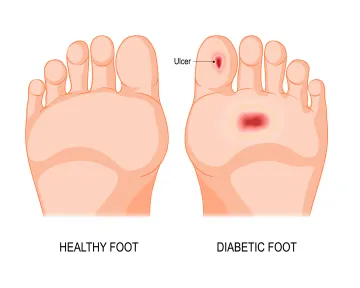
In a collaboration with Indiana University, the University of Arizona is engaged in enrolling eligible participants in the Diabetic Foot Ulcer Biofilm Infection and Recurrence clinical study. Emerging evidence underscores the significant risk that biofilm infection poses to the non-healing diabetic ulcers.
Diabetic foot ulcers (DFU) are one of the most common reasons for hospitalization of diabetic patients and frequently DFUs result in amputation of lower limbs. Of the one million people who undergo non-traumatic leg amputations annually worldwide, 75% are performed on people who have type 2 diabetes. Infection is a common complication of diabetic foot ulcers. Diabetes impairs immune defenses such that the ability to fight wound infection is weakened leading to worse outcomes. Emerging evidence underscores the significant risk that biofilm infection poses to the non-healing diabetic ulcers. Biofilms are estimated to account for 60% of chronic wound infections. In the biofilm form, bacteria are in a dormant metabolic state. Thus, standard clinical techniques used to detect infection may not detect biofilm infection. Biofilm infection may be viewed as a silent threat in wound care.
In a collaboration with Indiana University, the University of Arizona is engaged in enrolling eligible participants in the Diabetic Foot Ulcer Biofilm Infection and Recurrence clinical study. This study seeks to 1) examine how biofilm induced host tissue microRNAs disrupt barrier function of the repairing skin, 2) test if a history of wound biofilm infection is associated with deficient skin barrier function of the closed DFU, and 3) determine if DFUs with a history of biofilm infection is associated with higher rate of recidivism.
Trans-epidermal water loss is a reliable measure of skin barrier function18. It can be detected by clinical staff at the point of care non-invasively within 15 minutes with minimum training using an inexpensive hand-held pen like commercial device approved for clinical use. The current study proposes to verify if wounds with a history of biofilm infection have a higher incidence of recurrence.
